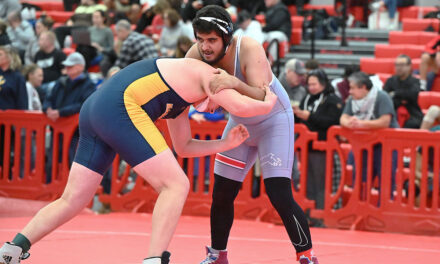By NEIL ZOLOT
WAKEFIELD – Total estimated costs for the proposed new Wakefield High School have risen from $220 million last April to more than $273 million in October, a 19.6% increase.
School Committee members plan to question the town’s delegation in the state legislature about the Massachusetts School Building Authority reimbursement rate for the new High School when Senator Jason Lewis and Representatives Kate Lipper-Garabedian and Donald Wong visit them in the next few weeks.
“It will be appropriate to make a vocal outreach as to what might change,” School Committee chair Tom Markham said at their meeting Tuesday. “We might ask for an increase to the bottom line and for the MSBA to reconsider what they consider ineligible costs.”
“Would they revisit the figure?” member Kevin Piskadlo asked rhetorically. “There’s been some disappointment as to the compensation level from the MSBA.”
“The MSBA has been under pressure to increase aid, but it takes a while for them to establish what they pay,” Lynn Stapleton of Owner’s Project Managers LeftField warned. “The more pressure the MSBA gets from cities and towns, the quicker they will act. There may be some exceptions to previous agreements. They’ve been asking a lot of projects to provide cost information. This is one.”
Any such effort will take place in light of new numbers from LeftField about increased costs as a result of new projections and delays in the schedule to build a new High School due to higher labor and material costs. 2022 cost increases were originally estimated to be 7-9 percent, but are now 15 percent. 2023 increased costs were originally estimated at 4-6 percent, but are now 10-15 percent and a move of the construction start date from the summer of 2023 to the following spring will result in a 4-6 percent escalation in costs.
Construction cost estimates rose from $175,557,629 in April to $223,701,204 in September, a 21.5 percent change. Total project costs rose from $220,000,000 in April to $273,701,204 in October, a 19.6% change. “A lot of people are saying everything will crash and costs will come down, but traditionally that’s not the case,” Stapleton said. “Historically, costs do not decrease but can flatten.”
LeftField classifies additional costs related to ground improvements, culvert relocation, roadwork, additional parking and development of outdoor spaces as “minimal,” but there will be some cost.
Regarding spaces unique to WMHS totaling $26,649,000, such as an expanded gym, an auxiliary gym, local cable TV facilities, an expanded band room and an auditorium stage, some of which will not be paid for through MSBA funds, they informed the School Committee, “If not part of the project, the town would need to spend additional and likely, more money to replicate as stand-alone projects.”
LeftField solicited three firms for construction-only cost estimates with PM&C coming in at a lower $220,341,337; AM Fogarty’s at a high $229,413,033 and Bond Building’s in the middle at $223,797,739. “Bond’s estimate was used as a basis for our total project cost,” Stapleton explained. “They will be our construction manager and will own their costs,” although she cautioned, “Various things could happen that we wouldn’t hold them to.”
“Anything short of anything that is completely out-of-whack, they’re responsible for,” Markham feels.
The town’s share of the total project cost will be $213.7 million, approximately 78 percent, which will result in $2.05 in taxes based on each $1,000 of property value for a 30-year bond. In April that was calculated to be $88 a month or $1,058 a year, but is now $115 a month and $1,384 a year.
LeftField feels the numbers are accurate. “We have a good handle on this and feel confident with the numbers we put together,” Stapleton said. “We had to have a budget that can’t be exceeded. We did a lot of research on indexes and financial statistics.
MSBA’s formula to determine their share is complicated, with caps on OPM and design fees, construction and soft costs, including an 8 percent cap on building costs, in this case $8,205,153 and a construction cap of $360 per square foot, totaling $137,529,944 in ineligible costs, leaving $86,267,795 eligible. “It’s difficult to explain,” Stapleton admitted.
The town’s reimbursement rate is 49.94 percent with 3.5 percent added from energy efficiency and good maintenance, totaling 53.44 percent of eligible costs only.
Of the total project cost of $273,701,204, $152,632,603 is ineligible. The “Basis of the Grant” at 53.14 percent is $58,263,088 with an additional contingency grant of $1,783,892, totaling the MSBA reimbursement at $60,046,980. “You get the full MSBA rate, but when you look at all the costs, it drops to an effective reimbursement rate,’ Stapleton said. “As costs go up, your reimbursement level goes down.”
“That’s an important distinction,” Markham wants people to know.
School Superintendent Doug Lyons asked Stapleton if Galvin Middle school was being built now would Wakefield get the same reimbursement rate of 54% on the cost of %74 million in 2012.
She answered that some MSBA costs caps were not in place then.
—
In other news, Ami Wall of the Logo Committee repeated inquiries to Ohio State University as to copyright infringement on one of the logo designs are still pending. She noted that the Logo Committee was advised by Counsel the cost of litigation might make it wise to abandon the logo in question.
She also feels use of the OSU-like logo violates codes against plagiarism in the Student Handbook.
“What are the next steps?” she asked, “If it goes away, do we choose from the other two or start over?”
As a result of this, the outcome of the student poll on logo options have not been released, but student representatives Lauren Mangarelli and Vanessa Westlake reported students like the OSU-like one best. “Everyone seems to enjoy it,” Mangarelli said.




